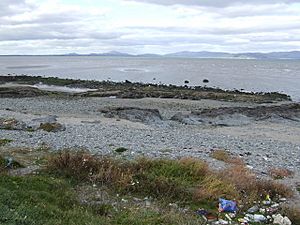Dundalk Bay facts for kids
Quick facts for kids
Designations
|
|
| Designated: | 7 June 1996 |
|---|---|
| Reference #: | 834 |
Dundalk Bay (Irish: Cuan Dhún Dealgan) is a large bay on the east coast of Ireland. It covers about 33 square kilometers. The inner part of the bay is quite shallow and sandy. When the tide goes out, large areas of sand and mud are exposed. This is called the intertidal zone.
Even though the bay is mostly influenced by the sea, several rivers flow into it from the west. For example, the Castletown River flows into the northwest part, and the smaller River Fane enters the southeast. The shores of the bay have many sandy and muddy areas. There are also large areas of salt marsh on the western side. The land around the bay is used for both farming and towns.
Contents
A Special Place for Nature
Dundalk Bay is recognized as a Special Area of Conservation. This means it's a very important place for nature. Its most important natural areas are the sandy and muddy flats that appear at low tide, and the big salt marshes.
Home to Many Creatures
The sand, gravel, and mud areas exposed at low tide cover more than 4,000 hectares. These areas are full of small creatures like worms, clams, and crabs. These tiny animals are the main food for tens of thousands of birds that visit the bay.
Many different types of birds, such as waders, gulls, and waterfowl, regularly feed here. Sometimes, more than 20,000 birds can be seen! Because so many birds rely on Dundalk Bay, it's important for bird populations both in Ireland and around the world. It has even been named a Ramsar site, which is a special international title for important wetlands.
Unique Plants of the Bay
The salt marshes in Dundalk Bay have special plants that can grow in salty conditions. You might see plants like sea-purslane and common cord-grass. Other plants found here include common saltmarsh-grass, thrift, red fescue, common scurvygrass, sea plantain, and sea rush. Closer to the sea, you'll find lots of glasswort.
There are also areas with pebbles and shingle (small stones) along the shore. Here, you can find plants like spear-leaved orache, sea mayweed, sea beet, sea rocket, wild carrot, sea holly, sea sandwort, and sea radish. Sometimes, you might even spot yellow horned-poppy and lyme-grass.
Rivers Flowing into the Bay
Several rivers bring fresh water into Dundalk Bay. Here are some of them:
- Several small streams from the Cooley Peninsula
- Flurry River (also known as River Ballymascanlan)
- Castletown River (also known as Creggan River) - This river is about 45 kilometers (28 miles) long.
- Its smaller branches include the Cully Water River (also called Falmore River or Dungooley River), which is about 23.3 kilometers (14.5 miles) long.
- Another branch is the Kilcurry River (also called Forkhill River), about 18.5 kilometers (11.5 miles) long.
- Rampart River, which flows through the center of Dundalk town before joining the bay.
- River Fane - This river is about 61.56 kilometers (38.25 miles) long.
- River Glyde - This river is about 55.9 kilometers long.
- A branch of the River Glyde is the River Dee, which is about 60.4 kilometers long.


